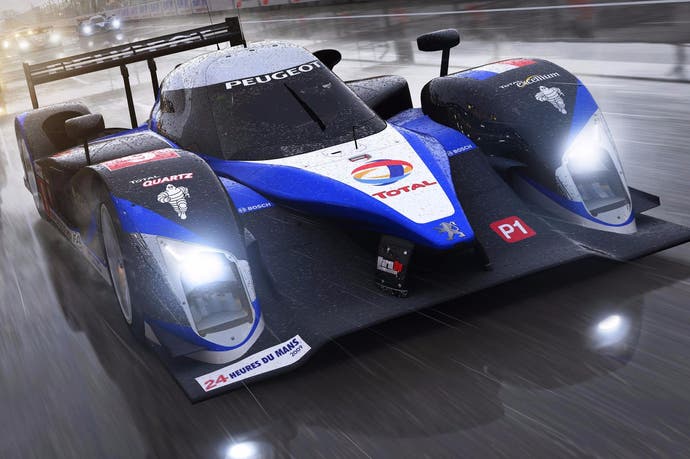Digital Foundry vs Forza Motorsport 6
The drive of your life?
In retrospect, Forza Motorsport 5 was something of a technological miracle bearing in mind the tumultuous Xbox One launch, characterised by rushed software and obvious technical challenges in working with the new console. For the most part, Turn 10 achieved a solid 1080p60 - an impressive achievement bearing in mind that most of the production occurred on unfinished hardware, with Microsoft engineers still tuning the hardware as the studio entered the final months of development. Forza Motorsport 6 is an important release then - it demonstrates what one of the most talented first-party development teams can achieve with a clear two-year run on final Xbox One hardware.
The new game is an object lesson in refinement, and its predecessor starts to look just a little rough around the edges by comparison. In technical terms Forza 5 remains a solid start for the series on Microsoft's new console, but it seems that Turn 10 was still feeling its way around the Xbox One architecture, carefully trying to balance a next-gen leap in graphical quality with the studio's uncompromising stance on 1080p60 gameplay. On top of that, the transition to the new engine clearly had implications for the volume of content the team was able to include, and there were a number of shortcomings: fewer cars and tracks than Forza 4 and a handling model that felt a little too excitable. Lighting could also appear quite harsh, while the lack of anisotropic filtering on elements of the presentation meant that the increase in texture detail on the roads was blurred out just a few feet away from the camera.
Free from the time constraints of a console launch deadline, Forza 6 is a more substantial game than its predecessor, providing both more content and some eagerly awaited gameplay modes. A much larger roster of cars and tracks is joined by new features such as wet weather and night-time races, in addition to a better structured single-player mode free from micro-transactions. From a technological standpoint, Turn 10 also brings about some welcome additions to the engine, though perhaps understandably, the insistence on targeting that unrelentingly solid 60fps still comes with some compromises. However, one major takeaway is that the studio hasn't thrown away much of the work it did on its predecessor - Turn 10 seems happy that it got the basics right on its first try, so we are seeing an iterative improvement from one game to the next, as opposed to the more dramatic leap we saw between Forza Motorsport 2 and its successor on Xbox 360.
Basic image quality appears similar to Forza 5, and so jaggies and shimmering across sub-pixel elements and fine details are commonplace across the scene. Forza 6 (like, we assume, its predecessor) uses EQAA for anti-aliasing, an AMD-specific hardware AA solution that sees sample fragment storage decoupled from coverage computations, thus allowing more flexibility from a memory/performance perspective. Essentially, it's an alternative implementation similar to MSAA and suffers from many of the same flaws. Coverage is regularly disrupted by how shading and post-processing are implemented in any given scene, often making it seem like there is little to no AA at all. Adjustments in the lighting model occasionally deliver a slightly cleaner image compared to Forza 5, but the difference is minimal at best.
Turn 10 has managed to squeeze yet more from the minuscule 16.67ms render-time available for each frame, resulting in a tangible increase in detail over Forza 5. The new Rio de Janeiro track showcases a higher level of graphical complexity than anything seen in Forza 5, with long draw distances and densely packed scenery filled with buildings, spectators, and plenty of incidental detail. Courses previously available in Forza 5 also see an upgrade: Sebring features the addition of fences erected on the sides of the track, while extra vehicles are seen in the background. Artistic alterations are made to some tracks in order to open up the landscape and better realise the level of detail on offer. The Prague circuit is an interesting example, where rows of trees that overhang the road are removed in one section of the track, thus opening up the exquisite view of the historical architecture on show.
The repositioning of art assets is often joined by tweaks in other areas too. Trees appear more lifelike, while texture detail is given a boost on some tracks. The sand banks at Laguna Seca feature more nuanced detail on the ground, whereas the same surfaces appeared blurry and indistinct on the last Forza - though, curiously, the mountains in the Bernese Alps appear to feature lower-resolution textures than before, resulting in a slight loss in clarity.
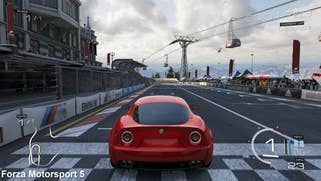
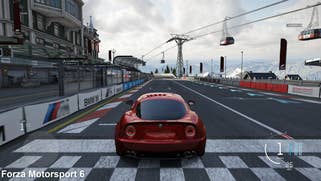
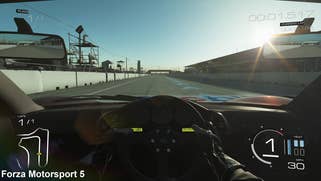
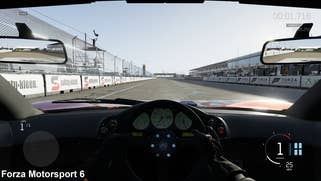
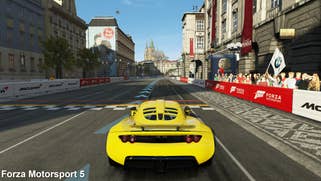
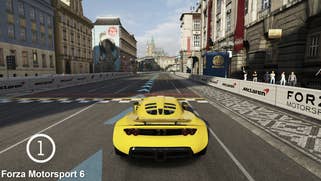
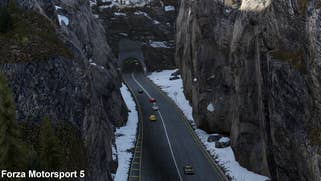

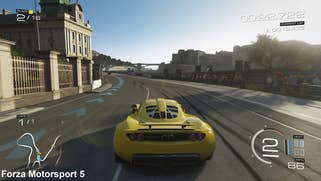
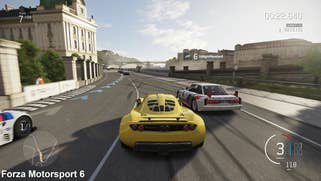
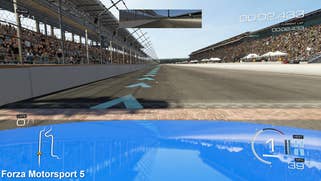
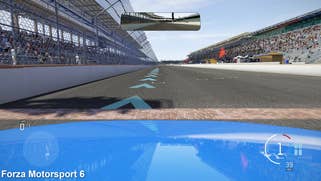

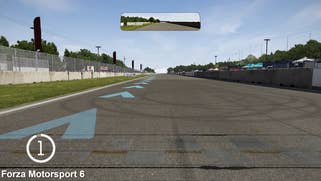


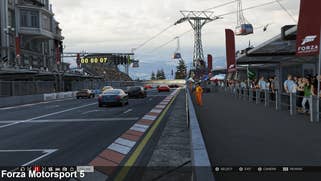
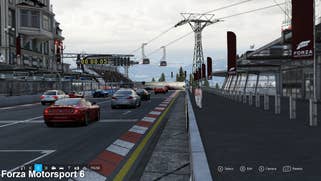
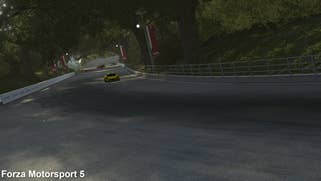

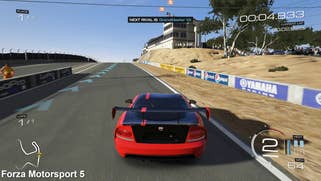



Elsewhere within the presentation, texture detail appears slightly clearer on the ground and road surface, though disappointingly these elements still tend to get blurred over a few metres away from the camera. It's possible that Turn 10 may be using different texture filtering methods for various elements of the scene (Project Cars did this), with Forza 6 seeing tweaks that refine the presentation. In some scenarios, it does look like the basic trilinear texture filtering of the old game gives was to a low level of anisotropic filtering in the new release, but it's certainly the case that higher resolution artwork is in play regardless.
The amount of alpha-based elements - such as dust and fog - is also increased over Forza 5, with the more liberal use of rolling fog across the rocky valleys of the Burmese Alps and over Prague's river. In other areas, shadow resolution and reflection quality appear to be a close match, as does depth of field. Environment shadows sometimes appear slightly smoother in several areas in Forza 6, but this doesn't visibly stand out during gameplay. A subtle - but important - enhancement comes in the form of particles, which are more liberally deployed in the sequel, often noticeable in collisions.
One of the biggest changes in Forza 6 is the appearance of night-time racing and wet weather conditions, along with what Turn 10 describes as '3D puddles', which we expected to build up over the course of a race. Indeed, the appearance of pouring rain and pools of water scattered across the ground has a tangible impact on handling, with very different physics deployed: cars obviously have less grip across the soaked tarmac compared to driving across dry road or grass, making careful throttle control even more important. As usual, the level of simulation here is superb - as far as it goes. According to Turn 10, Forza 6's 3D puddles impact handling based on a range of factors including the porousness of the underlying surface.
While the effects on the handling model work really well, the visual presentation can feel somewhat sterile. There is no variance to rain patterns or volume, with the effect staying the same throughout the entire race. The puddles of water on the ground also appear to be comprised of flat textures featuring a number of surface properties. Transparency, reflections and interaction with surrounding light sources are impressively handled, but physical interaction with the cars appears limited due to lack of a geometry-based body. The puddles don't react to the wheels as they drive through the surface, while splashes of water are thrown up in the form of flat alpha sprites. This is the compromise we need to accept in order to enjoy that completely consistent, locked 60fps.
Night-time racing also brings about a change in handling, with the drop in temperature reducing the amount of tyre grip, though the difference is very subtle compared to driving in daylight conditions. Most of the challenge is provided by how lighting is handled in the various tracks that support this feature: Daytona is illuminated by light sources all around the circuit, giving a clear view of the road ahead, while conversely, large sections of the Nurburgring feature no additional lighting beyond the car headlights, creating a black abyss that becomes trickier to tackle. The use of light sources to fundamentally change the gameplay experience here is a nice touch, though the lighting model sometimes appears a little harsh, with some scenes featuring more depth than others.
Both wet weather and night-time conditions make for more interesting races in Forza 6, but we are left wanting more after seeing how they add to the core gameplay mechanics. Both wet conditions and time of day are limited to just nine tracks out of the 23 available (those where the studio thinks they'll make the most impact), while rainy conditions are also limited to daytime racing too. Overall, the effects mostly work from a visual perspective and they succeed in spicing up the gameplay. The fact that frame-rate isn't impacted is a big deal, too - but there's also the sense that Turn 10 could perhaps have compromised too heavily: the effects are static, not dynamic, meaning that the uncertainty of variable weather conditions in any given race and how that affects handling isn't replicated, while the transition of the time of day is also missed.







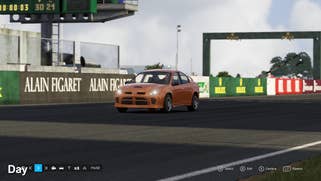

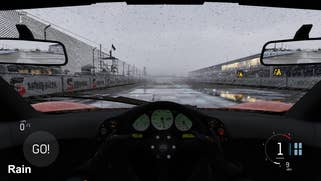


But there is a perfectly reasonable explanation for the limitations in these systems. Turn 10's physically-based lighting model relies on a combination of pre-computed ('baked') and real-time light sources to simulate global illumination and the resulting ambient lighting across the track. As such, it's impossible to introduce dynamic changes to time of day and weather conditions without significantly re-writing the current lighting model in favour of a real-time approach - something that would be a difficult task while targeting that uncompromising 60fps update.
One possible way forward would be to pre-compute a number of different time of day variants with some kind of interpolation for switching between them - it's a system that has been used in a number of other games. For example, Assassin's Creed 4 actually moves between eight pre-baked TODs in simulating a full 24-hour cycle. However, the increase in datasets and streaming could be overwhelming and the overall effect would perhaps look too compromised.
As things stand, there's only so much that can be done within a highly constricted amount of render time available, and in this case it's clear that Turn 10's main priority was in maintaining a rock solid frame-rate with consistent controller response and top-tier physics, in order to deliver a stable, high-precision racing experience. And in those respects, Forza 6 totally delivers: we never see a single dropped or torn frame throughout the whole experience. From start to finish, Turn 10 achieves an unwavering 60fps - and in this sense, there is yet more refinement over its predecessor: the very rare glitches and hitches found in Forza 5 are completely excised from this sequel. Put simply, the rock-solid consistency is the icing on the cake.
It's a cliché, but there is very definitely the sense that Forza Motorsport 6 is the game its predecessor should have been - the key issue users had with the last release concerned the tangible downgrade in the amount of cars and the number of tracks. Turn 10 did well in expanding the game post-launch, but it's only with the sequel that we get a similar kind of comprehensiveness that we saw in Forza 4 - and for many, that is enough to warrant a purchase.
But from a technological perspective, there's something else here that impresses us - namely, a level of ambition and polish indicative of the confidence that comes from an accomplished developer now firmly at home with the Xbox One platform. Some of the enhancements are genuinely spectacular - like the new Rio track - while others are gambles that may not completely pay off, such as the 24-car multiplayer.
But going forward, we've been wondering: where does Turn 10 go from here? The developer seems to be pushing for the features that the fanbase wants, but in the case of variable weather and night-time driving, we could well need a fundamental shift in the underlying technology to get that absolutely right. It's hard to imagine that features like this - along with a truly next-gen damage model - could be accommodated within the existing engine, without some level of performance compromise: and that's exactly what we get in competing titles like Project Cars. We can't wait to see where Turn 10 chooses to go next, but we suspect that another jump in the volume of content alone isn't going to cut it.
